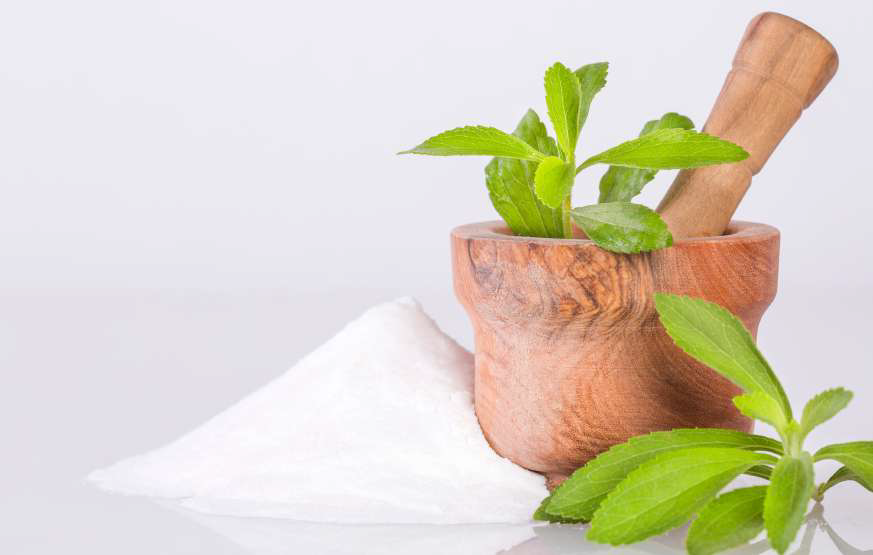If you’ve ever considered going sugar-free, you must have some understanding of what stevia is; if not, check out this blog.

To give a brief introduction, stevia is a herbal shrub indigenous to Paraguay. It is presently gaining high traction across the globe as a zero-calorie, natural, sugar alternative. As opposed; to the other sugar substitutes available in the market, it is plant-based and doesn’t have to be produced synthetically like artificial sweeteners. And, due to its processing in the body, it contributes to zero calories.
Native Americans have used stevia to sweeten foods and beverages for over 1500 years, whereas Japan has accepted the herb and its extracts since the 1970s. As a matter of fact, stevia owns Japan’s 40-45% of the sweetener market. With time, many more countries like India, South Korea, the Philippines, New Zealand, etc., have embraced this wonder herb.
Adhering to an acceptable daily intake (ADI) level of 4 mg/kg of body weight, stevia has the approval of well-known food regulatory bodies such as the FDA, FSSAI, JECFA, and EFSA. With research backing up the claim, it is safe for children, diabetic patients, pregnant women, and everyone alike, without a doubt.
The science of stevia
The sweetness in stevia is derived from the leaves of the plant, which contains steviol glycosides. These sweet-tasting compounds contribute to the rich profile of the plant, including protein, fiber, antioxidants, and amino acids. To date, more than 40 different glycosides have been identified, and they individually contribute to distinct taste profiles and sweetness intensity.
Taste buds located on the human tongue have receptors that identify the taste of the food we eat. Upon consumption, the receptors interact with the chemical compounds present in food, and along the neural pathway, a message is sent to the brain, which helps in perceiving the taste. While only one receptor is present to recognize the sweet taste, 25 different taste receptors identify a bitter taste, contributing to the signature bitter aftertaste of stevia. Nonetheless, the aftertaste can be minimized or eliminated, depending on the type of steviol glycoside consumed or by employing different taste-masking methods.

Metabolism
Steviol glycosides do not hydrolyze in the stomach or small intestine upon consumption. Instead, fully intact glycosides move to the large intestine, where it’s broken down to glucose and steviol. Steviol is modified in the liver to be excreted as steviol glucuronide whereas, the trace amount of the glucose generated is quickly used up, without any substantial activity.
Farming
Stevia belongs to the ‘sunflower family’ and is optimally grown in tropical and subtropical conditions. Cultivated in Paraguay, Kenya, the United States, China, Vietnam, India, Brazil, and other countries, it requires warm temperatures with lots of sunshine, well-draining soil, minimal frost, and sufficient rainfall. It is important to note that using chemical fertilizers can hamper the taste of the leaves.
When ideal conditions for growth are met, multiple harvests can be fulfilled in a year. Under the growing conditions offered in India, the stevia crop is harvested three times a year.

Extraction
Methods employed to extract steviol glycosides harvest these compounds in their natural state, the way they are found in the leaf, making no alterations in the chemical composition. Different organizations practice different extraction methods for obtaining desirable steviol glycosides, which contribute differently to the taste profile.
A standard method of extraction includes steeping the dried leaves in water and further filtering and purifying it to isolate the glycosides. At Arboreal, we use a 100% organic-certifiable extraction process, utilizing two FDA-approved reagents and no harmful chemicals.
In the market
The steviol glycosides collected in the extraction process are further utilized as pure extracts or used in developing sugar-free products. The primary extract varieties used in the stevia industry are powder, liquid, and leaf. Sweeteners produced with the help of stevia are a blend of pure stevia extract and other permitted ingredients, combined for ease of usage. Along with tabletop sweeteners, beverages, food products, pharmaceuticals are significant end-use sectors in the industry.
At present, the stevia market is growing exponentially, owing to consumer awareness, rising health concerns, and an increase in the number of organizations wanting to reformulate their products with reduced sugar content. According to a report by EMR, the global stevia market value reached USD 520.32 in 2020, and a robust growth rate during the period 2021-2026 is expected, extending the market to about USD 844.20. If you want to get started with stevia, you’ve come to the right place. We can help you turn your ideas into products to successful launch in 30 days. Learn more.


